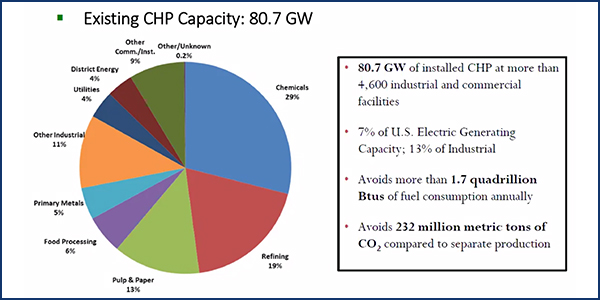Combined heat and power (CHP) systems harbor great potential for small applications, but adopters face the current reality that system costs do not fall in proportion to size, according to proponents.
CHP systems, or cogeneration, are an efficient way to generate electricity and heat from a single fuel source, such as biomass or natural gas. CHP is fuel-efficient, as it uses otherwise wasted heat productively for heating or cooling. It also reduces the need to purchase distributed electricity from the grid, which increases energy security.
The Environmental and Energy Technology Council of Maine on Tuesday hosted a webinar to discuss emerging markets for the technology.
David Dvorak, director of New England Combined Heat and Power Technical Assistance Partnership and professor of mechanical engineering technology at the University of Maine, said more than half the 80.7 GW of CHP installed capacity in the U.S. are “typically very large-scale systems.” Dvorak said these types of CHP systems “work very well,” but they also need to be installed by on-site engineers.
In smaller applications, Dvorak sees changes. “Out of 4,000 sites that we currently have in our installation database, what we’re seeing is that in the past four years, there have been quite a few smaller-scale systems, for instance in multifamily [homes] and schools, that are put into place,” he said. “These tend to be smaller systems where there may or may not be in-house expertise to do a full engineering analysis.”
Dvorak said this represents “technical potential” in New England.
Ian Burnes, strategic initiatives program manager for Efficiency Maine, said that CHP is “a great technology, but the upfront installation cost “is really challenging.” Large-scale CHP installed at an assisted-living facility can cost $300,000 for the total system cost and $80,000 for electrical engineering.
Dvorak added that even with small-scale or micro-CHP systems, the interconnection costs and associated expenses do not scale down with them.
“There’s a certain aspect of [cost] that’s fixed, and it becomes a larger fraction of the total cost, and this is a real challenge, but we see more and more opportunities in these smaller systems,” Dvorak said. “We’re hoping to find ways actually to see more of these small-scale systems installed.”
Burnes said Efficiency Maine offers capped financial incentives on total project costs and 50% coverage up to $20,000 for a technical assistance study and free scoping audit of utility data that includes a final report.
Lizzy Reinholt, senior director of sustainability and corporate affairs for Summit Utilities, added that getting people to realize the benefits of CHP is “really important.”
Reinholt said local distribution companies have leadership roles in building a sustainable energy future. Summit — which operates in five states, including Maine — is focused on renewable natural gas and its role in reducing emissions and helping states meet their climate goals. She said Maine Gov. Janet Mills has been pushing an aggressive agenda around emissions reductions and creating the Maine Climate Council, which recently released a draft of its four-year Climate Action Plan that included recommendations for CHP.
It is an “exciting time to work in the energy field,” she said, adding that it is also a critical and transitional time, as regulatory and legislative frameworks need adaptation to better link to goals for reducing emissions and mitigating climate change impacts. Building strong partnerships with lawmakers and regulators is essential, she said.
“Right now, there is a strong push to find a silver bullet to solving all the problems we face, both reducing emissions and reducing costs, and there are no easy answers,” Reinholt said. “I feel grateful for the work that’s already been done that has stayed technology agnostic and instead focused on outcomes. How do we keep that moving forward so that we can be ready to seize on those innovations and emerging technologies in the marketplace?”




